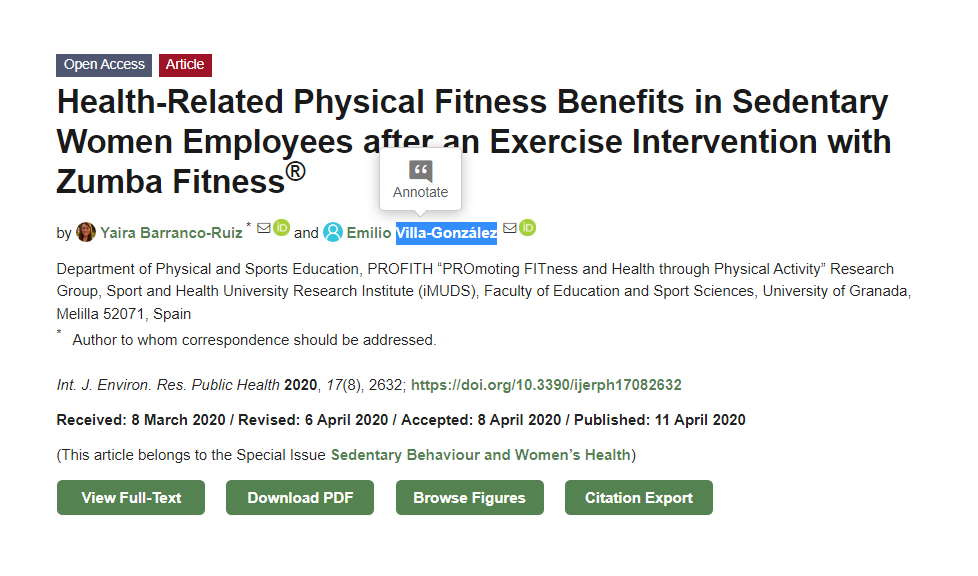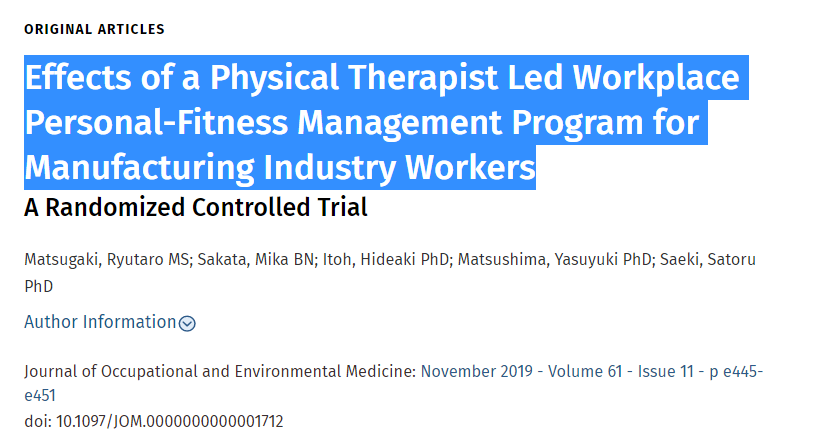Article 1

Dancing classes have been a way of enjoying physical activity while learning new skills for centuries. Zumba is a mixture of Latino dance exercises and cardio that may benefit fitness and health, specifically among women. Barranco-Ruiz and Villa-González (2020) have analyzed the implementation of Zumba fitness programs on sedentary-style female employees. The study involved 98 participants split into three groups. The first was the control group, used to compare results to the rest. Another was the endurance-training Zumba class group, and the third focused on Zumba strengthening exercises. The study found that both interventions helped improve the physical fitness of physically-inactive women. This article can be used to inform the study about the potential options of intervention and affecting the target population. It also shows how cardio and dance-based exercise are effective when applicated to sedentary populations. At the same time, it demonstrates the need for space in similar interventions.
Article 2

Social bonding and cooperation are critical factors in the success or failure of health-related fitness interventions in employees. Ren et al. (2018) examine the possibility of using cooperative fitness-tracking to reinforce fitness goals and promote a more active lifestyle. The study reviewed ten dyads during three weeks. The first week was a control week, the second featured vigorous exercising and the intervention itself, and the third week saw how the habit is maintained. Ren et al. (2018) found that “the awareness of being physically active stimulates the exchange of knowledge to support active lifestyles and facilitate including fitness breaks in the daily work routine” (p. 17). This article can be used to demonstrate how peer pressure could serve as an additional motivator for fitness. This particular element is very easy to combine with other potential activities. At the same time, it cannot serve as a stand-alone measure to improve fitness.
Article 3

Workforce fitness programs typically feature generalized group activities. At the same time, it is argued that individualized therapist-led workplace fitness programs offer better results. The study by Matsugaki et al. (2019) investigates and compares the effectiveness of such workplace fitness programs. The study featured 469 employees split into two groups, with one receiving personalized training programs and the other – generalized fitness instructions (Matsugaki et al., 2019). The study showed better self-efficacy as well as higher results for individualized programs. The usefulness of this study for the proposed project lies in demonstrating peak efficiency of personalized considerations towards individual employee. Companies that can afford that kind of care see great increases in loyalty and performance. At the same time, not every company can afford to hire and maintain a personal fitness trainer. Despite the intervention proving superior, generalized practice also performed reasonably well. This evidence could be used to further support the primary intervention.
Article 4

Finally, the option of personal fitness trackers has been explored in many companies. The study by Torres and Zhang (2021) inspects the influence of trackers on hotel workers. Devices like Fitbit were used to help measure activity. The study found that employees with the devices showed better physical activity and healthier eating (Torres & Zhang, 2021). Therefore, it is a potential option that can be adapted to many different types of workplaces. This article serves as a basis for the supported intervention, and shows how a mundane and easy-to-get gadget can influence fitness (Torres & Zhang, 2021). At the same time, it demonstrates the popularity of such gadgets in different generations of employees and its effect not only on physical activity but also on nutrition. The intervention outline in this article can be adapted to other organizations, such as CNAQ. Overall, it is an excellent basis for the budding proposal.
References
Barranco-Ruiz, Y., & Villa-González, E. (2020). Health-related physical fitness benefits in
sedentary women employees after an exercise intervention with Zumba Fitness®. International Journal of Environmental Research and Public Health, 17(8), 2632.
Matsugaki, R., Sakata, M., Itoh, H., Matsushima, Y., & Saeki, S. (2019). Effects of a physical therapist led workplace Personal-Fitness management program for manufacturing industry workers: a randomized controlled trial. Journal of Occupational and Environmental Medicine, 61(11), e445-e451.
Ren, X., Yu, B., Lu, Y., & Brombacher, A. (2018). Exploring cooperative fitness tracking to encourage physical activity among office workers. Proceedings of the ACM on Human-Computer Interaction, 2, 1-20.
Torres, E. N., & Zhang, T. (2021). The impact of wearable devices on employee wellness programs: A study of hotel industry workers. International Journal of Hospitality Management, 93, 102769.